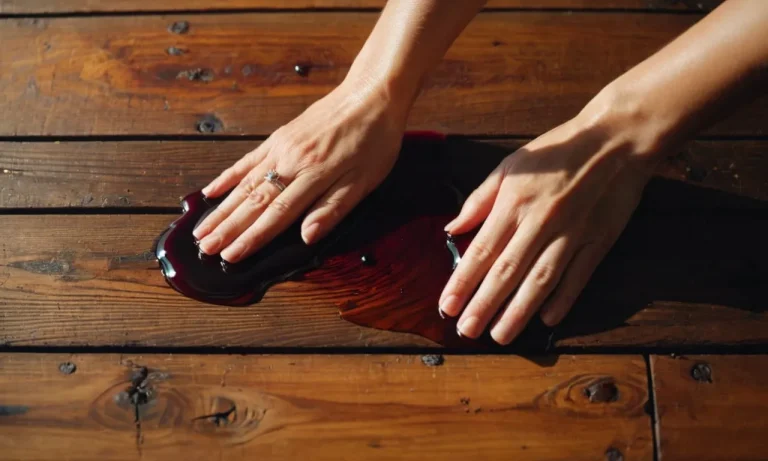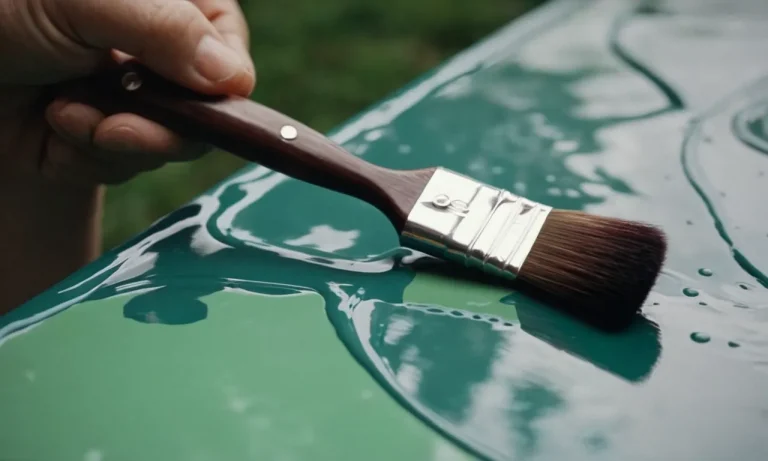Can You Wash Spray Paint Off Clothes? A Detailed Guide
If you’ve ever gotten spray paint on your clothes, you know it can be a distressing situation. Those bright splatters and stains may seem impossible to remove. But don’t toss your clothes just yet! With the right techniques and supplies, you can get spray paint out of fabric.
If you’re short on time, here’s the quick answer: While challenging, it is possible to wash spray paint off clothes in many cases using solvents like acetone or alcohol before laundering. Heat setting spray paint can make removal much more difficult.
The type of fabric and paint, time elapsed, and removal method all impact success.
How Spray Paint Bonds to Fabric
Spray paint can bond to fabric in a few different ways, and understanding this process can help you effectively remove it from your clothes. The bond between spray paint and fabric is primarily influenced by two factors: the paint binders used and the characteristics of the fabric itself.
Paint Binders and Drying Process
Paint binders are crucial components of spray paint that allow it to adhere to various surfaces, including fabric. These binders are responsible for creating a strong bond between the paint and the fabric fibers.
Different types of spray paint may contain different binders, which can affect the adhesion properties.
As the spray paint is applied to fabric, the binders in the paint begin to dry and harden. This drying process is essential for the paint to form a durable bond with the fabric. Depending on the type of paint and the drying conditions, the drying time can vary.
It is important to note that the longer the paint has been on the fabric, the stronger the bond may become.
Fabric Characteristics and Paint Adhesion
The characteristics of the fabric also play a significant role in how spray paint bonds to it. Different fabrics have different textures, porosities, and surface properties, which can affect the adhesion of the paint.
Some fabrics, like cotton or denim, have more porous surfaces that allow the paint to penetrate and bond effectively. On the other hand, smoother and more tightly woven fabrics may offer less surface area for the paint to adhere to.
Fabric coatings or finishes can also impact the adhesion of spray paint. Fabrics with water-repellent or stain-resistant coatings may have a barrier that prevents the paint from fully bonding. Additionally, fabrics treated with fabric softeners or other chemicals may have reduced adhesion properties.
It’s important to note that removing spray paint from fabric can be challenging, especially if it has fully dried and bonded. However, there are methods and products available that can help you effectively remove the paint without damaging the fabric.
It’s always a good idea to test any removal method on a small, inconspicuous area of the fabric first to ensure it doesn’t cause any unwanted damage.
For more information on removing spray paint from fabric, you can visit www.thespruce.com which provides helpful tips and step-by-step guides.
Factors That Affect Spray Paint Removal
When it comes to removing spray paint from clothes, there are several factors that can influence the success of the process. Understanding these factors can help you choose the most effective method for removing the paint without causing damage to your garments.
Paint Type
The type of spray paint used can greatly impact the ease of removal. Different types of spray paint have different chemical compositions, which can make some paints more stubborn to remove than others.
For example, oil-based spray paints tend to be more difficult to remove compared to water-based ones. It’s important to identify the type of paint used on your clothes before attempting any removal methods.
Fabric Type
The fabric composition of your clothes is another crucial factor to consider. Some fabrics, such as cotton or polyester, are more forgiving when it comes to removing spray paint, as they can withstand more aggressive cleaning methods.
On the other hand, delicate fabrics like silk or wool require more gentle treatment to avoid damaging the fibers. Always check the care label on your clothes and choose a removal method that is suitable for the fabric type.
Time Elapsed
The amount of time that has passed since the spray paint incident can also affect the success of removal. The longer the paint has had to dry and set into the fabric, the more challenging it may be to remove.
It’s always best to act quickly and try to remove the paint as soon as possible after it has been sprayed onto your clothes.
Heat Setting
The heat setting used when drying the clothes can impact the removal process. High heat can cause the paint to set further into the fabric, making it more difficult to remove. If you’ve accidentally sprayed paint on your clothes, avoid drying them in high heat until you’ve successfully removed the paint.
Instead, opt for air drying or using a low heat setting.
Remember, the success of removing spray paint from clothes depends on a combination of these factors. It’s always recommended to test any cleaning method on a small, inconspicuous area of the garment first to ensure it doesn’t cause any damage.
Removing Fresh Spray Paint
Solvents for Cleaning
When it comes to removing fresh spray paint from clothes, using solvents can be an effective method. One common solvent is acetone, which can be found in nail polish remover. Simply dab a small amount of acetone onto a clean cloth and gently blot the affected area.
Be cautious not to rub too vigorously, as this could spread the paint or damage the fabric. Another alternative is rubbing alcohol, which can also dissolve spray paint. Apply a small amount of rubbing alcohol onto a cloth and gently dab the stained area.
Remember to test these solvents on a small, inconspicuous area of the fabric first to ensure they do not cause any damage.
For tougher stains, you may need to use a stronger solvent like mineral spirits or paint thinner. These solvents are more potent, so it’s crucial to use them in a well-ventilated area and follow the manufacturer’s instructions carefully.
Apply a small amount onto a clean cloth and gently blot the stain. Again, testing on a small area of the fabric beforehand is recommended.
Laundering Considerations
After using a solvent to remove the spray paint, it’s essential to launder the clothing properly. Check the care label on the garment for specific washing instructions. In most cases, you can wash the item in the washing machine using a regular laundry detergent.
Make sure to choose the appropriate water temperature and cycle setting as recommended by the manufacturer.
If the spray paint stain remains after laundering, do not put the clothing in the dryer as the heat can cause the paint to set further into the fabric. Instead, repeat the solvent cleaning process or consider taking the item to a professional cleaner who can provide specialized care.
It’s worth noting that the success of removing spray paint from clothing depends on factors such as the type of fabric, the type of paint used, and how quickly you take action. Fresh stains are generally easier to remove than dried or set-in ones.
Therefore, it’s crucial to tackle the stain as soon as possible to increase the chances of successful removal.
For more information on removing spray paint stains and other helpful tips, you can visit websites such as Good Housekeeping or The Spruce.
Removing Dried/Set-In Spray Paint
Accidentally getting spray paint on your clothes can be frustrating, but don’t worry – there are several methods you can try to remove dried or set-in spray paint. Here are some effective techniques:
Chemical Removers
Chemical removers can be quite effective in removing dried or set-in spray paint from clothes. One popular option is using acetone, which is commonly found in nail polish remover. Simply soak a cloth in acetone and gently dab the affected area, being careful not to rub too hard as it may damage the fabric.
Another option is using rubbing alcohol or a paint thinner specifically designed for removing paint stains. Always test these chemicals on a small, inconspicuous area of the fabric first to ensure they won’t cause any damage.
Abrasive Techniques
If the spray paint has already dried and set into the fabric, you may need to resort to more abrasive techniques. One method is to gently scrape off the dried paint with a dull knife or spoon, taking care not to damage the fabric.
You can also try using a toothbrush or a soft-bristled brush to scrub the stain with a mixture of warm water and laundry detergent. Be patient and persistent, as it may take some time for the paint to loosen and come off.
Bleaching
In some cases, bleaching can be an effective method for removing dried or set-in spray paint stains. However, it’s important to note that bleaching can also weaken the fabric and may cause discoloration.
Before using bleach, check the care instructions on the clothing label to ensure it is safe to use. If it is, dilute the bleach with water according to the instructions and apply it to the stained area. Let it sit for a few minutes, then rinse thoroughly with water.
Repeat if necessary, but be cautious not to overbleach the fabric.
Overpainting
If all else fails and the spray paint stain is still visible, you can consider overpainting the affected area. This method works best on dark-colored fabrics and requires a fabric paint or fabric marker that matches the color of the garment.
Simply apply the fabric paint over the spray paint stain, following the instructions provided with the product. This technique can help camouflage the stain and make it less noticeable.
Remember, it’s always best to treat spray paint stains as soon as possible. The longer the paint sits on the fabric, the more difficult it can be to remove. If you’re unsure about any of these methods or if the fabric is delicate or valuable, it’s recommended to seek professional advice or take the garment to a professional cleaner.
Preventing Spray Paint Stains
When it comes to spray painting, prevention is better than cure. Taking the necessary precautions can save your clothes from getting stained. Here are some effective ways to prevent spray paint stains:
Covering Surfaces and Skin
Before starting your spray painting project, it’s important to cover the surfaces and skin that you want to protect. Use plastic sheets or drop cloths to cover the area where you’ll be working. This will ensure that any overspray or accidental paint drips don’t end up on your clothes.
Additionally, it’s a good idea to wear gloves to protect your hands from any paint splatters.
Aprons/Smocks
Wearing an apron or smock can be a great way to protect your clothes from spray paint stains. These protective garments are designed to shield your clothing from any accidental paint splatters. They are typically made from materials that are easy to clean, such as nylon or polyester.
Aprons and smocks come in various styles and sizes, so you can choose one that suits your needs and preferences.
Removing Excess Quickly
If you accidentally get spray paint on your clothes, it’s important to act quickly. The longer the paint sits on the fabric, the harder it will be to remove. Start by blotting the excess paint with a clean cloth or paper towel. Avoid rubbing the stain, as it can spread and make the situation worse.
Once you’ve removed as much paint as possible, treat the stain with a stain remover or a mixture of dish soap and warm water. Gently scrub the stain and rinse with cold water. Repeat the process if needed until the stain is gone.
Remember: While these preventive measures can significantly reduce the chances of spray paint stains, accidents can still happen. If you find yourself dealing with a stubborn stain that won’t come off, it’s best to consult a professional cleaner or take your garment to a dry cleaner.
They have the expertise and specialized products to effectively remove tough stains without damaging your clothes.
Conclusion
While removing spray paint from fabric can be tricky, don’t resign yourself to stained clothes just yet. With prompt action and the right stain removal products and techniques, you stand a good chance of erasing those marks. Just be sure to consider the paint and fabric types as you assess options.
Approach fresh stains differently than old, set-in ones. And when possible, take preventive steps to avoid spray paint mishaps in the first place!







